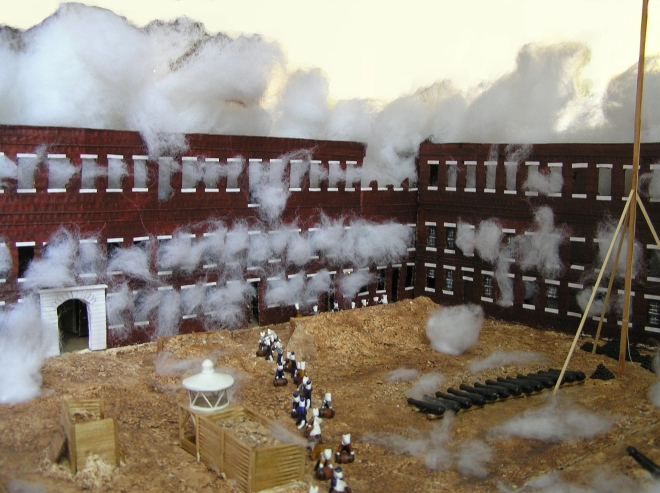We started “The Bombardment of Fort Sumter” in 2011 in honor of the 150th anniversary of the event in Charleston, SC, where the first shots of the Civil War were fired on April 12-13, 1861.
The diorama shows a point during the second day of the bombardment. This moment in time might not seem very important at first glance. But what are the men doing strung across the parade ground? Rolling barrels of gunpowder, of all things. In fact, they were working desperately to save themselves and the fort from being blown up! The powder magazine was housed in the officers’ quarters, which had caught fire. By the second day of fighting, the fire was coming dangerously close to the powder magazine and could not be stopped. If it reached the powder stored in the magazine, the explosion would be catastrophic.
The only thing left to do was to try to get the powder out of the magazine. Every man who wasn’t working a cannon helped to form a line across the parade ground to roll the powder barrels to an area they thought would be safer. Of course, all the time they were doing that, Confederate shot was raining down and exploding all over the parade ground. A spark to one of the barrels would have meant death to the men around it.
Thankfully, no one was hit and they managed to salvage 50-100 barrels before they had to shut the door, bank it with dirt, and hope for the best. Later in the day, they had to throw many of the barrels out of the fort to keep them from exploding inside it, and a shot jammed the magazine door shut, leaving them with only five barrels of gunpowder, total. The garrison surrendered later that day.
Take time to notice some details on this diorama. Why is the flag at half-staff? The men in the fort had dipped the colors to signal the fleet just outside the harbor, but as they did so, a shot hit the flagstaff and damaged it such that they could not raise the colors again.
You’ll also see a dismounted cannon, the barrel of which is halfway sticking out of a stair tower. A little howitzer lies dismounted next to its carriage. What happened? The cannons on the top (“barbette”) tier of the fort were bigger than those in the lower level, but the barbette tier was much too exposed to enemy fire. The garrison didn’t have men to waste, so orders were to stay downstairs. But firing the smaller guns was frustrating, since they didn’t do much damage to the Confederate positions.

The ten-inch Columbiad fired by the sergeants.
Two sergeants decided they’d had enough and snuck upstairs, against orders. They fired the Columbiad, then couldn’t run it forward again because that would have taken eight men. So they fired it from the recoiled position. The second recoil dismounted the gun, which took out the howitzer, too!
The cannon positions are taken from photographs taken in the days following the surrender of the fort. We think it’s exciting to match up the accounts with the period photographs, and bring it all to 3-D. We hope it will give you a new perspective on history, too!


